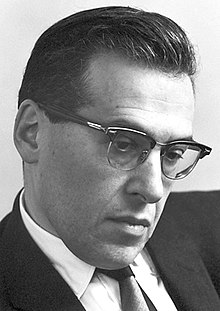Julian Schwinger
Julian Seymour Schwinger (February 12, 1918 – July 16, 1994) was an American theoretical physicist. He is best known for his work on quantum electrodynamics (QED), in particular for developing a relativistically invariant perturbation theory, and for renormalizing QED to one loop order.

Schwinger is recognized as an important physicist, responsible for much of modern quantum field theory, including a variational approach, and the equations of motion for quantum fields. He developed the first electroweak model, and the first example of confinement in 1+1 dimensions. He is responsible for the theory of multiple neutrinos, Schwinger terms, and the theory of the spin-3/2 field. Schwinger was jointly awarded the Nobel Prize in Physics in 1965 for his work on quantum electrodynamics (QED), along with Richard Feynman and Shin'ichirō Tomonaga.
| This article about a physicist is a stub. You can help out with Wikiquote by expanding it! |
Quotes
edit- Time appears in quantum mechanics as a continuous parameter which represents an abstraction of the dynamical role of the measurement apparatus. The requirement of relativistic invariance invites the extension of this abstraction to include space and time coordinates. The implication that space-time localized measurements are a useful, if practically unrealizable idealization may be incorrect, but it is a grave error dismiss the concept on the basis of a priori notions of measurability.
- "Relativistic Quantum Field Theory, Nobel Lecture, December 11, 1965". Nobel Lectures, Physics 1963-1970. Amsterdam: Elsevier Publishing Company. 1972. pp. 140–152. (quote from p. 142)
- If my history lesson has done nothing else, it should have reminded you that, during any given period in the evolving history of physics, the prevailing, main line, climate of opinion was likely as not to be wrong, as seen in the light of later developments. And yet, in those earlier times, with relatively few individuals involved, change did occur, but slowly... What is fundamentally different in the present day situation in high energy physics is that large numbers of workers are involved, with corresponding pressures to conformity and resistance to any deflection in direction of the main stream, and that the time scale of one scientific generation is much too long for the rapid pace of experimental discovery. I also have a secret fear that new generations may not necessarily have the opportunity to become familiar with dissident ideas.
- as quoted by Sameer Shah in "If you can't join 'em, beat 'em": Julian Schwinger's Conflicts in Physics. Directions in Cultural History, The UCLA Historical Journal, Volume 21, 2005-2006, p. 50
- Perhaps the most important contribution to science that the Royal Society has made in its three centuries of existence is its early role in publishing Newton's masterful account of his discoveries: Mathematical Principles of Natural Philosophy—the Principia.
- Einstein's Legacy: The Unity of Space and Time (2002) p. 2
- Is the purpose of theoretical physics to be no more than a cataloging of all the things that can happen when particles interact with each other and separate? Or is it to be an understanding at a deeper level in which there are things that are not directly observable (as the underlying quantized fields are) but in terms of which we shall have a more fundamental understanding?
- Quantum Mechanics - Symbolism of Atomic Measurements (2001) p. 24 f.
Quotes about Schwinger
edit- For two years in the late 1950s I was a postdoc at Harvard. Julian Schwinger was the leading light in theoretical physics at the time. We, the postdocs and junior faculty, audited whatever course he happened to be teaching. The material was always original. The lectures were on Wednesdays, and afterward the small group of us would have lunch with Schwinger at Chez Dreyfus in Cambridge. We would be joined by another small group from MIT that included Vikki Weisskopf. If Schwinger had any new ideas, he would try them out on Weisskopf. As it happened on this occasion, he had developed a “theory of everything.” Some of this theory survives in the work of other people. In 1962, he published a paper on “Gauge invariance and mass.”9 … In it he raised the question of whether one could have a massive vector meson in a theory that had an underlying gauge invariance. This possibility … inspired P. W. Anderson to use these ideas in condensed matter physics.10...
9 J. Schwinger, “Gauge invariance and mass,” Phys. Rev. 125, 397–398 1962 .
10 P. W. Anderson, “Plasmons, gauge invariance and mass,” Phys. Rev. 130, 439–442 1963.- Jeremy Bernstein, (January 2011)"A question of mass". American Journal of Physics 79 (1): 25–31. DOI:10.1119/1.3487939. (quote from p. 30)
- During this period I attended two sessions of the Michigan summer school at which Schwinger (1948) and Feynman (1949) described their respective reformulations of QED. Schwinger’s was deeper and more complete while Feynman’s was easier to use but at that time incomplete. One may give a feeling for the impact of Schwinger by quoting Dyson who wrote home that ”in a few months we shall have forgotten what pre-Schwinger physics was like.” Bethe at that time described this period as the most exciting in physics since the great days of 1925-30 when quantum mechanics was being discovered.
- Robert Finkelstein: (2016). "My Century of Physics". arXiv preprint arXiv:1612.00079.